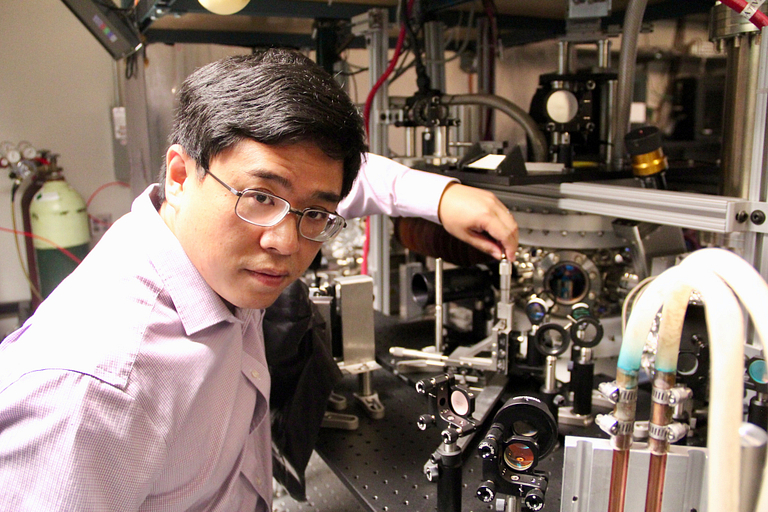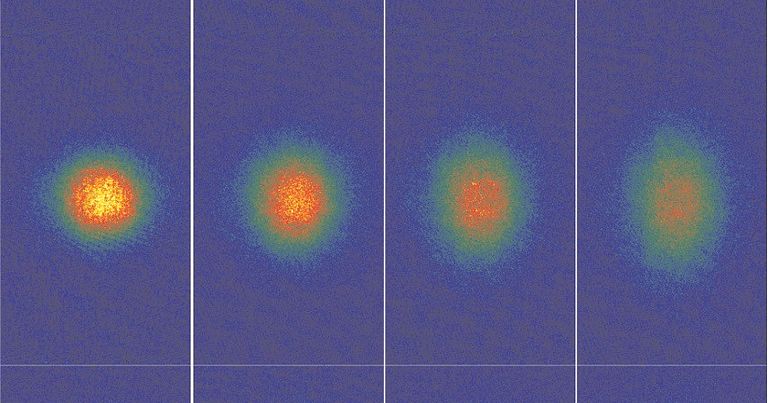
As the fall chill finally descends onto campus, you might feel a little cold at night. Best to grab that sweater or jacket.
In Le Luo’s lab, in the basement of the Science, Engineering and Technology Building, atoms need more than a cardigan as the particle physicist employs the coldest of cold physics. Nestled between numerous pipes, hoses, wires and infrared lasers is an ion trap that slows atoms down to a crawl. To do this, it must be cold, less than one millionth of a degree Kelvin above absolute zero. That’s -459 degrees Fahrenheit.
“To see the real quantum mechanics’ effects, you need to cool down the temperature,” explained Luo, an adjunct professor in the School of Science. “When you reach that low temperature, you will see the particles. They won’t behave like particles, but like quantum mechanical waves.”
Description of the following video:
Video transcript
“Physics professor freezes particles to almost absolute zero” video on https://youtu.be/zEMn2n6LpAs
[Video: IUPUI presents bug opens in upper left corner.]
[Words appear: Le Luo, IUPUI Physics faculty member.]
[Le Luo speaks: AMO physics is atomic, molecular, and optical physics. The main object of study are atoms, molecules, and the photons. We use the atoms, molecules and the photons to study the fundamental principle of quantum mechanics. And we also want to apply the principle of quantum mechanics to control these microscopic particles.
So that those particles, for example, the trapped ions or cold atoms, can be used for information processing or more precise sensors. To see the real quantum mechanics effects, you need to cool down the object to very, very low temperature. For example, close to absolute zero. When you reach that low temperature, you will see the particles, for example, atoms, who are not like the bullet or peanuts.
They won’t behave like a particle. They actually behave like quantum mechanical waves.]
[Video: Panning shot of Luo’s lab equipment]
[Nasser speaks: Okay, this is the very nice customized viewport. From this viewport, we shine the laser light from up and down, left and right, to make the magnetic optical track. So, in those trap, we trap these atoms.
So, then the atoms slow down from a centimeter per second to millimeter per second. So, we know the velocity is corresponding to the temperature. When the velocity is so low that means temperature is so low. So, in the end we reach absolute zero temperature.]
[Words appear: IUPUI Fulfilling the Promise, iupui.edu]
[End of transcript]
The particles slow down from thousands of meters per second to a millimeter per second, Luo said.
The waves the particles make when slowed down are the key to understanding and improving quantum mechanics. Luo’s goal is to translate the research to quantum computing, which makes lightning-quick supercomputers faster and better.
Before things get cold, Luo first has to heat up his atoms. A recent experiment saw a lithium-6 isotope get heated in a specialized “oven” to 750 degrees, which turned the lithium to atomic vapor.
“We then shoot the laser light to have a collision with the atoms,” said Luo, showing the length the vapor travels through his lab in order to slow down.
While the roots of atomic, molecular and optical physics date back to the 18th century when atoms were first theorized, modern applications and interest have accelerated with advancements in technology, from lasers to supercomputers.

Luo and Ph.D. student Leonardo de Melo entered their lab space with a blank canvas. They built their own research facility from scratch.
“I had to not only get introduced to a lot of the theory, but also to the equipment,” de Melo said. “It was very exciting to learn all of the equipment.”
The researchers’ atom trap features portals for the naked eye, but most of the optical data is sent to a cluster of computers for visualization.
“We shine the laser light from up and down, left and right to make a magnetic optic trap,” Luo said. “Then it gets down to almost absolute zero.”
These overnight fall temperatures are technically freezing, but not quite all-matter-slowing-down freezing. Luo’s atom trap is where the real cool is.

